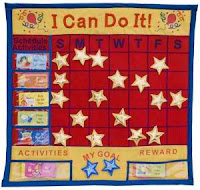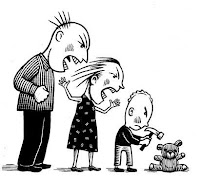Behavior charts consist of two primary components: (1) parental expectations (e.g., doing chores, behaving, handling self-care tasks, etc.) and (2) the reward for meeting such expectations.
Behavior charts can be very effective in getting kids to do what moms and dads want. But often times, parents find that their Aspergers or high-functioning autistic (HFA) children don't respond to charts – either because the concept is too abstract, or the gratification is too delayed. Adjusting and simplifying the chart to your youngster’s particular needs and abilities can make the difference between success and failure with this particular parenting technique.
Here's how to successfully employ behavior charts for children on the autism spectrum:
1. Be sure to have plenty of consistency, patience and a willingness to try new ideas.
2. Coupons for desired activities (or avoidance of undesired ones) can serve as a good tangible reward for behavior-chart goals. Try pre-made printable coupons (see below) or create some of your own.
3. Don't load up the chart with unrealistic items you'd like your youngster to complete (e.g., making all A’s on the next report card). A couple “big goals” are fine every now and then, but make sure there are some things he is already doing on a regular basis, and a couple of very easy things that will always earn some points or check marks no matter what. Add one "miscellaneous" category for rewarding random acts of good behavior.
4. Don't offer anything you can't deliver. Big trips or large toys are risky promises. Losing them will be a negative experience for your youngster if he doesn't succeed in earning enough points, and they may be hard for you to deliver reliably. If your youngster is earning an allowance, put the money aside early in the week so you'll be sure to deliver on payday.
5. Figure out a reasonable time period for your youngster to go without a reward. For a very young child, or one with severe behavior issues, it may be as little as 15 minutes. Let your youngster know that for every 15 minutes of appropriate behavior, she will get a reward (e.g., a sticker on a piece of paper, a small snack, a coin, etc.). If the behavior during any specific increment doesn't measure up, the reward is missed, but the time resets and the next increment of time is open for change.
6. If your youngster makes a partial attempt at something (e.g., doing a chore), but does not completely follow through (e.g., he made his bed, but didn’t pick up his clothes off the floor), make sure he always gets some sort of reward. The idea here is to be positive about successes. Offer a descending scale of rewards for points attained (e.g., smaller amounts of money, reduced time to play computer games, etc.). If your youngster can work with you on this, set up the rewards together and agree on them. Put the possibilities on the chart.
7. If your youngster is not always able to do the items on the chart without help, then increase the number of points available for that task, and award them according to effort (e.g., if your youngster has trouble getting dressed in the mornings, you might award 5 points if he does it himself, 3 points if you just have to help a little, and 1 point if you have to get him dressed - but he cooperates). In this way, you're able to make a positive experience out of almost any outcome.
8. If your youngster just doesn't "get" a chart with points or checkmarks, try putting happy faces or stickers on the chart for successful results – or skip the chart idea entirely and devise another method of tracking your youngster’s successful moments (e.g., put pennies in a jar, add beads to a string, add Legos to a Lego tower, add rubber bands to a rubber-band ball, etc.). Anything that involves “adding on” to something will work.
9. Make the chart all about rewarding positive behavior – not penalizing negative behavior. Make a big deal about putting points up - or checking items off. Don't apply blame for items not checked. The chart is an opportunity to get extra credit for things done right.
10. Most behavior charts are intended to improve your youngster's performance over time, or provide weekly motivators for meeting your expectations. Sometimes, though, you need to reward behavior in the short-term (e.g., making it through a church service, surviving a mall trip, etc.). Using a chart to break down the activity into small reward-able units of time can make it easier for your youngster to get it done.
11. Reviewing the chart every night gives you an opportunity to provide positive feedback for jobs well done. If your youngster responds best to short-term rewards, you might give something like a sticker for a minimum of points earned. At the end of the week, the stickers can be "cashed-in" for bigger rewards.
12. Some Aspergers and HFA children are highly motivated by an allowance. For them, the pay-off at the end of the week should be in cash. Establish the amount in advance and put it on the chart. If money isn't motivating, find something that is (e.g., small toy, fast-food lunch, computer game time, a "get out of time-out free" card, etc.). Be creative and find the things your youngster really craves, not the things that would make sense to you.
13. Your youngster's abilities and your family's needs change, thus the chart should change too. Do this in collaboration with your son or daughter when possible. Add new chores as your youngster's abilities increase, and eliminate things he is rarely successful at. Keep brainstorming new rewards and new methods of earning them. The secret to a good behavior chart is making sure your youngster is always able to earn points – and excited about doing so.
14. Decide on a couple things you would most like done "better" by your youngster (e.g., putting shoes away, sharing toys with siblings, helping with chores when asked, good routine when getting ready for bed, etc.). With a permanent marker, write or draw these points on the side of the chart. Then write or draw the acceptable reward you are happy to offer for compliance.
15. Don’t forget about behavior at school. Ask your youngster's teacher to send home a behavior report every day. If necessary, send in a simple form that can be checked off quickly. Award points based on performance. Make a big deal of putting these points on the chart, but if your youngster has a bad day, don't make a big deal of not adding them. Simply wish him better luck tomorrow.
Making a Behavior Chart from Scratch—
1. Write out a list of goals you would like to place on the behavior chart. These might be chores, behavior modifications, or every day habits. Whatever you decide, make a “top five list” of priorities to place on the chart.
2. Open up a word-processing program (e.g., Microsoft Word) or calculation software (e.g., Microsoft Excel). Use a simple chart or graph template of your choosing to make your behavior chart. If you do not find one, you can simply draw one in Word or freehand with a marker.
3. At the side of the chart, make five sections and label each section with one of your goals. For example, "Clean Room" can be section one, "Courteous to Siblings" can be section two, "Sharing Toys" can be section three, etc. On the top of the chart list the date of the month, or just leave it blank. Make rows of squares next to each section so columns are formed with approximately 10-30 squares in each row.
4. Shop with your youngster to pick out stickers to be used as a reward. Getting him/her involved with the creation of the chart – as well as the goal reaching – can really make a strong and positive impact. Choose stickers that are brightly colored or feature your youngster's favorite characters. Place a sticker on the chart every time a good behavior is completed.
5. Decide what the reward will be once a row on the good behavior chart is filled. Note these rewards somewhere on the chart, ideally along the bottom or below the graph. Make your reward intentions clear from the start, so a youngster will not expect too much or think too little of the behavior chart. Brainstorm with your youngster to come up with goal deadlines and rewards.
6. Tack or tape the good behavior chart in a visible, common area of the home. This may be the kitchen, living room or hallway. Encourage other family members to verbally praise the youngster when a sticker is earned, or a goal is near completion. Create a new good behavior chart with fresh goals once the current ones are achieved.
Highly Acclaimed Parenting Programs Offered by Online Parent Support, LLC:










